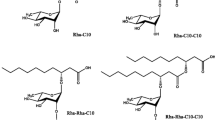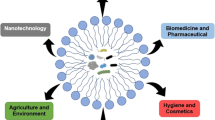Abstract
Glycolipid biosurfactants produced by bacteria and yeasts provide significant opportunities to replace chemical surfactants with sustainable biologically produced alternatives in bulk commercial products such as laundry detergents and surface cleaners. Sophorolipids are already available in sufficient yield to make their use feasible while rhamnolipids and mannosylerythritol lipids require further development. The ability to tailor the biosurfactant produced to the specific needs of the product formulation will be an important future step.



Similar content being viewed by others
References
Arutchelvi JI, Bhaduri S, Uppara PV, Doble M (2008) Mannosylerythritol lipids: a review. J Ind Microbiol Biotechnol 35:1559–1570
Banat IM, Franzetti A, Gandolfi I, Bestetti G, Martinotti MG, Fracchia L, Smyth TJ, Marchant R (2010) Microbial biosurfactants production, applications and future potential. Appl Microbiol Biotechnol 87:427–444
Caiazza NC, Shanks RMQ, O’Toole GA (2005) Rhamnolipids modulate swarming motility patterns of Pseudomonas aeruginosa. J Bacteriol 187:7351–7361
Casas JA, Garcia-Ochoa F (1999) Sophorolipid production by Candida bombicola: medium composition and culture methods. J Biosci Bioeng 88:488–494
Chen ML, Penfold J, Thomas RK, Smyth TJP, Perfumo A, Marchant R, Banat IM, Stevenson P, Parry A, Tucker I, Grillo I (2010a) Mixing behavior of the biosurfactant, rhamnolipid, with a conventional anionic surfactant, sodium dodecyl benzene sulfonate. Langmuir 26:17958–17968
Chen ML, Penfold J, Thomas RK, Smyth TJP, Perfumo A, Marchant R, Banat IM, Stevenson P, Parry A, Tucker I, Grillo I (2010b) Solution self-assembly and adsorption at the air-water interface of the monorhamnose and dirhamnose rhamnolipids and their mixtures. Langmuir 26:18281–18292
Chen ML, Dong CC, Penfold J, Thomas RK, Smyth TJP, Perfumo A, Marchant R, Banat IM, Stevenson P, Parry A, Tucker I, Campbell RA (2011) Adsorption of sophorolipid biosurfactants on their own and mixed with sodium dodecyl benzene sulfonate at the air/water interface. Langmuir 27:854–8866
Davila AM, Marchal R, Vandecasteele JP (1997) Sophorose lipid fermentation with differentiated substrate supply for growth and production phases. Appl Microbiol Biotechnol 47:496–501
Desai JD, Banat IM (1997) Microbial production of surfactants and their commercial potential. Microbiol Mol Biol Rev 61:47–64
Dubeau D, Déziel E, Woods DE, Lépine F (2009) Burkholderia thailandensis harbors two identical rhl gene clusters responsible for the biosynthesis of rhamnolipids. BMC Microbiol 9:263–274
Dusane DH, Nancharaiah YV, Zinjarde SS, Venugopalan VP (2010) Rhamnolipid mediated disruption of marine Bacillus pumilus biofilms. Colloids Surf Biointerfaces 81:242–248
Fracchia L, Cavallo M, Martinotti MG, Banat IM (2012) Biosurfactants and bioemulsifiers biomedical and related applications—present status and future potentials, biomedical science, engineering and technology, Chap. 14, pp 325–370; Dhanjoo N. Ghista (Eds), ISBN: 978-953-307-471-9, InTech
Franzetti A, Gandolfi I, Bestetti G, Banat IM (2011) Biosurfactant and bioremediation, successes and failures. In: Plaza G (ed) Trends in bioremediation and phytoremediation. Research Signpost, Kerala, pp 145–156
Fukuoka T, Morita T, Konishi M, Imura T, Sakai H, Kitamoto D (2007) Structural characterisation and surface-active properties of a new glycolipid biosurfactant, mono-acylated mannosylerythritol lipid, produced from glucose by Pseudozyma antarctica. Appl Microbiol Biotechnol 76:801–810
Fukuoka T, Yanagihara T, Imura T, Morita T, Sakai H, Abe M, Kitamoto D (2011) Enzymatic synthesis of a novel glycolipid biosurfactant, mannosylerythritol lipid-D and its aqueous phase behavior. Carbohydr Res 346:266–271
Guilmanov V, Ballistreri A, Impallomeni G, Gross RA (2002) Oxygen transfer rate and sophorose lipid production by Candida bombicola. Biotechnol Bioeng 77:489–494
Gunther IVNW, Nunez A, Fett W, Solaiman DK (2005) Production of rhamnolipids by Pseudomonas chlororaphis, a nonpathogenic bacterium. Appl Environ Microbiol 71:2288–2293
Haussler S, Nimtz M, Domke T, Wray V, Steinmetz I (1998) Purification and characterisation of a cytotoxic exolipid of Burkholderia pseudomallei. Infect Immun 66:1588–1593
Hewald S, Linne U, Scherer M, Marahiel MA, Kämper J, Bölker M (2006) Identification of a gene cluster for biosynthesis of mannosylerythritol lipids in the basidiomycetous fungus Ustilago maydis. Appl Environ Microbiol 72:5469–5477
Kitamoto D, Ikegami T, Suzuki T, Sasaki A, Takeyama Y, Idemoto Y, Koura N, Yanagishita H (2001) Microbial conversion of n-alkanes into glycolipid biosurfactants, mannosylerythritol lipids by Pseudozyma antarctica. Biotechnol Lett 23:1709–1714
Klekner V, Kosaric N, Zhou QH (1991) Sophorose lipids produced from sucrose. Biotechnol Lett 13:345–348
Lang S, Wullbrandt D (1999) Rhamnose lipids—biosynthesis, microbial production and application potential. Appl Microbiol Biotechnol 51:22–32
Makkar RS, Cameotra SS, Banat IM (2011) Advances in utilization of renewable substrates for biosurfactant production. AMB Express 1:5
Mata-Sandoval JC, Karns J, Torrents A (2001) Effect of nutritional and environmental conditions on the production and composition of rhamnolipids by P. aeruginosa UG2. Microbiol Res 155:249–256
Myers D (2006) Surfactant science and technology, 3rd edn. Wiley-Interscience, New York
Ochsner U, Fiechter A, Reiser J (1994) Isolation, characterisation and expression in Escherichia coli of the Pseudomonas aeruginosa rhlAB genes encoding a rhamnosyltransferase involved in rhamnolipid biosurfactant synthesis. J Biol Chem 269:19787–19795
Penfold J, Chen ML, Thomas RK, Dong CC, Smyth TJP, Perfumo A, Marchant R, Banat IM, Stevenson P, Parry A, Tucker I, Grillo I (2011) Solution self-assembly of the sophorolipid biosurfactant and its mixture with anionic surfactant sodium dodecyl benzene sulfonate. Langmuir 27:8867–8877
Perfumo A, Banat IM, Canganella F, Marchant R (2006) Rhamnolipid production by a novel thermotolerant hydrocarbon-degrading Pseudomonas aeruginosa AP02-1. Appl Microbiol Biotechnol 72:132–138
Perfumo A, Smyth T, Marchant R, Banat IM (2010) Production and roles of biosurfactants and bioemulsifiers in accessing hydrophobic substrates. In: Timmis KN (ed) Handbook of hydrocarbon and lipid microbiology. Springer, Berlin, pp 1501–1512
Piljac A, Stipcevic T, Piljac-Zegarac J, Piljac G (2008) Successful treatment of chronic decubitus ulcer with 0.1 % dirhamnolipid ointment. J Cutan Med Surg 12:142–146
Rodrigues L, Banat IM, Teixeira J, Oliveira R (2006) Biosurfactants: potential applications in medicine. J Antimicrob Chemother 57:609–618
Rodrigues L, Banat IM, Teixeira J, Oliveira R (2007) Strategies for the prevention of microbial biofilm formation on silicone rubber voice prostheses. J Biomed Mater Res 81B(2):358–370
Ron EZ, Rosenberg E (2001) Natural roles of biosurfactants. Environ Microbiol 3:229–236
Saerens KMJ, Zhang JX, Saey L, Van Bogaert INA, Soetaert W (2011) Cloning and functional characterization of the UDP-glucosyltransferase UgtB1 involved in sophorolipid production by Candida bombicola and creation of a glucolipid-producing yeast strain. Yeast 28:279–292
Smyth T, Perfumo A, Marchant R, Banat I (2010a) Directed microbial biosynthesis of deuterated biosurfactants and potential future application to other bioactive molecules. Appl Microbiol Biotechnol 87:1347–1354
Smyth T, Perfumo A, Marchant R, Banat I (2010b) Isolation and analysis of low molecular weight microbial glycolipids. In: Timmis KN (ed) Handbook of hydrocarbon and lipid microbiology. Springer, Berlin, pp 3705–3723
Smyth TJP, Perfumo A, McClean S, Marchant R, Banat IM (2010c) Isolation and analysis of lipopeptides and high molecular weight biosurfactants. In: Timmis KN (ed) Handbook of hydrocarbon and lipid microbiology. Springer, Berlin, pp 3689–3704
Soberón-Chávez G, Lépine F, Déziel E (2005) Production of rhamnolipids by Pseudomonas aeruginosa. Appl Microbiol Biotechnol 68:718–725
Stoimenova E, Vasileva-Tonkova E, Sotirova A, Galabova D, Lalchev Z (2009) Evaluation of different carbon sources for growth and biosurfactant production by Pseudomonas fluorescens isolated from wastewaters. Z Naturforsch 64:96–102
Van Bogaert INA, Saerens K, De Muynck C, Develter D, Soetaert W, Vandamme EJ (2007) Microbial production and application of sophorolipids. Appl Microbiol Biotechnol 76:23–34
Van Bogaert INA, Sabirova J, Develter D, Soetaert W, Vandamme EJ (2009) Knocking out the MFE-2 gene of Candida bombicola leads to improved medium-chain sophorolipid production. FEMS Yeast Res 9:610–617
Van Bogaert INA, Fleurackers S, Van Kerrebroeck S, Develter D, Soetaert W (2011) Production of new-to-nature sophorolipids by cultivating the yeast Candida bombicola on unconventional hydrophobic substrates. Biotechnol Bioeng 108:734–741
Van Hamme JD, Singh A, Ward OP (2006) Physiological aspects, Part 1 in a series of papers devoted to surfactants in microbiology and biotechnology. Biotechnol Adv 24:604–620
Vasileva-Tonkova E, Galabova D, Stoimenova E, Lalchev Z (2006) Production and properties of biosurfactants from a newly isolated Pseudomonas fluorescens HW-6 growing on hexadecane. Z Naturforsch 61:553–559
Zhu K, Rock CO (2008) RhlA converts β-hydroxyacyl-acyl carrier protein intermediates in fatty acid synthesis to the β-hydroxydecanoyl-β-hydroxydecanoate component of rhamnolipids in Pseudomonas aeruginosa. J Bacteriol 190:3147–3154
Author information
Authors and Affiliations
Corresponding author
Rights and permissions
About this article
Cite this article
Marchant, R., Banat, I.M. Biosurfactants: a sustainable replacement for chemical surfactants?. Biotechnol Lett 34, 1597–1605 (2012). https://doi.org/10.1007/s10529-012-0956-x
Received:
Accepted:
Published:
Issue Date:
DOI: https://doi.org/10.1007/s10529-012-0956-x




